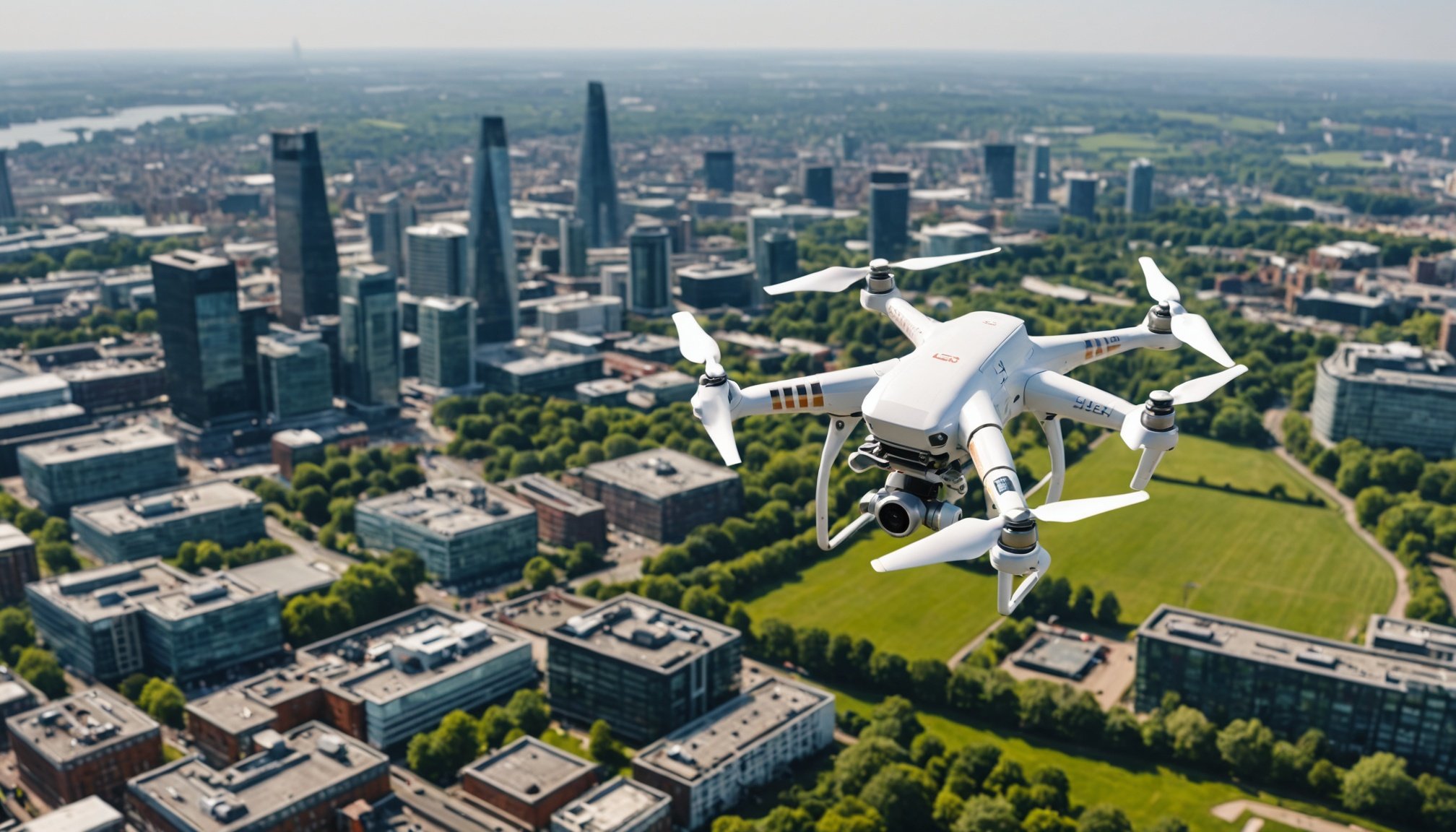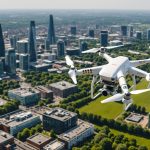Understanding UK Drone Regulations
Navigating the UK’s drone laws is essential for both recreational and commercial users. The Civil Aviation Authority (CAA) sets the framework, ensuring safe and legal drone operations. Regulatory compliance involves understanding key legislations, such as the Air Navigation Order 2016 and specific permissions required for certain flight activities.
Civil Aviation Authority (CAA) Drone Regulations
The CAA is the main body responsible for monitoring drone activities. Their guidelines balance innovation with public and airspace safety. They provide vital information, including height limits, distance from people, and no-fly zones. Adhering to CAA regulations helps drone operators avoid legal penalties.
Have you seen this : Key considerations for uk companies to assess before integrating ai in customer service
Key Legislation Influencing Drone Operations
Understanding legislation like the Air Navigation Order is crucial. It outlines the fundamental dos and don’ts of drone flying. Specific rules apply regarding weight limits and camera usage, all designed to protect privacy and wellbeing.
Differences Between Recreational and Commercial Use
While recreational pilots enjoy more flexibility, commercial operations require additional compliance. This includes obtaining the CAA’s Operational Authorisation. Regulatory differences mainly concern the risk assessment and potential impact on the public, mandating higher safety standards for commercial purposes. Embracing these legal frameworks ensures responsible and compliant drone usage.
Also read : Innovative approaches for uk healthcare providers to effectively implement ai diagnostics
Essential Legal Requirements for Businesses
Operating a drone commercially requires understanding several compliance requirements. Without adherence to these, businesses may face significant legal challenges.
Firstly, businesses must secure important permits and licenses. These operational permissions are crucial for ensuring that drone activities comply with local and national regulations. Depending on the country, organizations such as the Federal Aviation Administration (FAA) in the United States may oversee these permissions.
Drone insurance requirements are another critical consideration. Insurance typically covers damages to the drone, liabilities in case of an accident, or potential harm to third parties. Without drone insurance, businesses expose themselves to financial risks that could arise from unforeseen incidents.
Moreover, registration processes for drones and their operators are mandatory. This process often involves marking the drone with a unique identification number and registering it with the relevant authorities, similar to how vehicles are registered. Failing to do so can result in fines or operational limitations.
In summary, businesses must diligently adhere to these compliance requirements— from securing operational permissions and understanding insurance needs, to ensuring proper registration. These steps not only protect the business but also enhance operational efficiency.
Navigating Compliance Guidelines
Understanding compliance strategies is crucial for safe and effective drone operations. Ensuring compliance with CAA regulations requires a firm grasp of several best practices. Firstly, always keep abreast of changes in safety standards and integrate these adjustments into operational guidelines. This involves regular reviews and updates to safety management systems, aligning them with the latest regulatory expectations.
Implementing a robust safety management system is essential. This system should include documented processes for risk assessment and mitigation, ensuring that every drone operation adheres to a highly defined set of safety standards. Consider establishing a dedicated team to oversee compliance and safety audits regularly.
Pilot training is another critical area. Comprehensive training programs should be developed, focusing on operational guidelines tailored to the specific needs and challenges of your drone operations. These guidelines must cover necessary flight procedures, emergency protocols, and regular skill assessments to maintain a high level of operational readiness.
Remember, adherence to CAA regulations does not only enhance safety but also boosts the credibility of your operations. Align your compliance strategies with these guidelines to foster a culture of safety and professionalism in every aspect of drone operation.
Implications of Non-Compliance
Delving into drone regulations, the consequences of infringement can be quite severe. Non-compliance can lead to significant penalties. For instance, companies that disregard guidelines may face hefty fines, impacting their financial standing. Fines can vary depending on the extent and nature of the violation.
Legal risks associated with non-compliance are especially hazardous for businesses where drone technology is integral. Beyond fines, companies risk severe reputational damage and loss of trust among stakeholders. Navigating these legal hurdles can also incur substantial legal costs and consume valuable time that could be better spent on business growth.
Various enforcement actions highlight the gravity of adhering to regulations. One notable example involved a delivery service company operating drones without appropriate clearances. Their non-compliance resulted in costly legal proceedings and a halt to their operations until all regulations were strictly followed. Such enforcement actions serve as essential reminders of the importance of compliance.
Businesses must remain vigilant and ensure all drone activities comply with local and international regulations. Emphasising education and continuous monitoring can help mitigate the legal risks and prevent undesirable consequences of infringement.
Case Studies of Successful Drone Integration
Integrating drone technology has been transformative for various industries, offering fresh insights into business practices and models. A prime example of effective drone deployment is seen in the agriculture sector. By utilizing drones, farms have enhanced crop monitoring, enabling precise pesticide application and irrigation. This technological leap boosts crop yields while minimizing waste.
In construction, drones have revolutionized site surveys. Firms like Skycatch and Kespry have seamlessly integrated drones, allowing for detailed 3D mapping and progress tracking. Such advancements enhance project accuracy and efficiency, reducing costs and timelines considerably.
Logistics giants, such as Amazon and UPS, have also embraced drones. They use them for last-mile delivery, overcoming challenges in dense urban environments and enhancing service reach.
Lessons from these businesses emphasize the importance of complying with drone regulations. This involves understanding local aviation laws and obtaining necessary certifications. Adhering to these regulations not only avoids legal hurdles but also builds public trust.
Different industries are identifying specific applications of drones, showcasing their potential. From monitoring power lines to conducting wildlife conservation, diverse sectors worldwide benefit by adhering to necessary regulatory frameworks. As these examples demonstrate, thoughtful drone deployment strengthens business models, offering innovative solutions and efficiencies.
Future Trends in Drone Legislation
The realm of emerging regulations will soon envelop UK businesses as anticipated changes in drone laws unfold. With the rise of commercial and recreational drone use, regulatory bodies are working to ensure future compliance with updated guidelines. One anticipated shift is tightening airspace restrictions, aiming to align with the rapid technological advancements in drones.
Technological progress has undoubtedly impacted drone legislation. Innovations such as enhanced data collection capabilities and improved drone autonomy call for new laws to address privacy concerns and air safety. These advancements will likely prompt adjustments in categorising drone operations based on complexity and potential risks.
Industry developments continue to be pivotal. Stakeholders—from business leaders to hobbyists—play a critical role in shaping future drone policies. Their involvement in policy discussions ensures that regulations remain practical and tailored to diverse needs. By engaging in dialogue, stakeholders help balance innovation and safety, fostering an environment where drone technology can thrive responsibly.
In sum, understanding and adapting to these emerging regulations becomes essential for thriving in the evolving landscape of drone operations. Keeping abreast of technological changes and participating in policy-making discussions will facilitate smooth integration into future frameworks.











